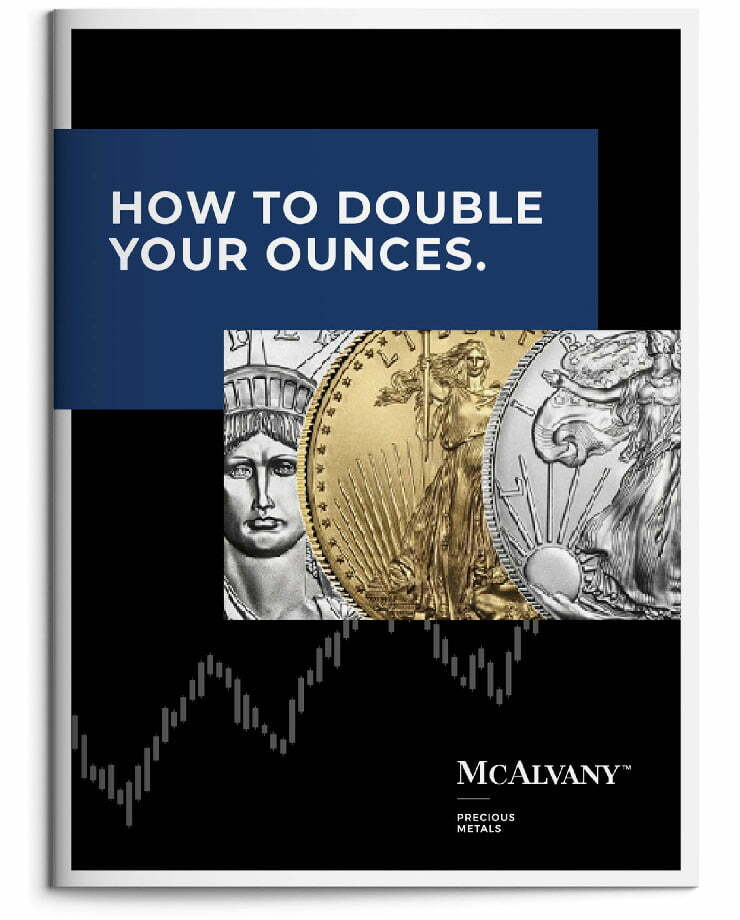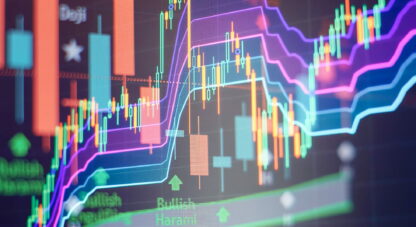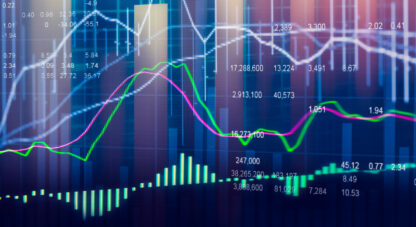Podcast: Play in new window
- Gold’s Rise Since 2008 Has Been A Policy Choice Of Central Banks
- David Rosenberg Sees $6k Gold In 3-5 Years
- Attached Charts: Gold Price VS Central Bank Buying

“In a bear market, there’s no straight line from overvaluation to undervaluation. It’s a process, and this happens over and over again, all the way down. Believing the worst is behind them, believing that a bottom is in with each successive wave of optimism suggested by the price action higher, but the counter-trend moves tend to be short and sharp in the opposite direction from that secular trend.
For the secular bear, the counter-trend moves up are powerful. It drives positive energy. It drives the fear of missing out. Maybe we put in the lows and you’ve got to get in now. At the same time, you’re drawing in those new investors with a hope that the market is in the early stage of a new bull trend.
That is, in my view, precisely where we are today.” —David McAlvany
* * *
Kevin: Welcome to the McAlvany Weekly Commentary. I’m Kevin Orrick, along with David McAlvany.
David, we’re coming out of our meeting, and I’m like, “Oh my gosh.” We’ve got to talk about a couple of the things that you brought up in the meeting and Morgan brought up in the meeting, but I’m just going to throw this out right off the bat. You said central banks have an unstoppable appetite for gold. Tell me about that.
David: Well, you see these things through a different lens, and it’s not a common lens that we are used to. We see timing decisions, we see price opportunities. You want to buy low and sell high, and the appetite for gold by central banks is a policy choice. It is a political decision to diversify away from dollars, away from Treasuries, and move towards having a higher percentage allocation to gold.
And if you look back over the last 50 years, we are still a fraction of what central bank holdings used to be. We could see gold holdings increase an additional four- to fivefold just to match where we were in the ’70s and ’80s. So very unpopular through the ’80s and ’90s to own gold. We moved towards financial assets, reserve asset managers did. But that trend changed pretty dramatically in the year 2009, and it’s been the primary driver of the gold market to date.
It also explains why there’s a number of items that have been left behind, so to say, because the retail investor who is making a decision based on timing, based on preferences for other risk assets, has yet to enter the market. So we think of junk silver trading at no premiums. We think of the pre-1933 US $20 gold pieces, no premiums. We think of gold mining shares, trading at discounts in some instances still at a discount to their net asset value.
It is not a space that is overcrowded. It is not a space that has attracted hardly any interest at all. And so it’s just a different calculus. The retail investor is looking through one particular lens, and it’s not that of a policy choice. But that’s why we’ve seen such a significant shift from 2009 to the present. Central banks flipped the switch and decided they wanted to increase reserves in gold again.
Kevin: Morgan Lewis showed us two charts, and I have to say, Dave, after doing this 38 years, the correlation between those two charts was one of the most profound correlations I’ve ever seen. And what it shows is the price of gold from 2008 til now and central bank buying from 2008 until now, when they started to become net buyers, not net sellers of gold. And you had asked the group here at McAlvany Precious Metals, you said, “Do you know the difference between a policy choice and an investment decision?” Because really, what we’re seeing with gold is a policy choice. Central banks don’t buy based on whether they’re going to make money or not. It’s policy.
David: Yeah, I think those charts— They say a picture is worth a thousand words, and this does demonstrate pretty clearly that you’ve got central bank activity which is directly impacting the price. And we think that will continue to the degree that their buying is a fixture in the marketplace. They’re a price-insensitive buyer, and it is one of the discouraging aspects of wanting to see lower prices to have a better cost basis.
We may not see what you would normally see. The ebbs and the flows of any market, where it surges forward and then retreats and then surges forward again to new all-time highs, we typically see that retreat as an opportunity to position at lower prices. Many investors are not being given the opportunity to position in gold because central banks are so active in the space and we’re seeing very shallow corrections.
What I’d love to see, 3,150. What I’d love to see, 3,000. What I’d love to see, 2,850. I mean I can make a case for $2,500 gold, but that doesn’t mean that we get what we want. And that is the nature of a bull market. The basic contrast being: bull markets have almost a design element that keeps people out, and bear markets have a design element, a psychological aspect, which keeps people in.
You don’t want to be wrong. You’ve made your bets, you’re invested, and when you go into a bear market, you just can’t be proven wrong. So every dip you buy, and you add and you lower your cost basis until it moves lower and you just can’t come to terms with having been wrong. A bear market is designed to keep you trapped in your positions. A bull market designed to keep you out.
Kevin: It’s interesting, the retail investor is what we’re talking about. And at some point the retail investor will come in late to the party and push that market much, much higher. But I love your point.
I’m going to shift to the stock market for a moment. Retail investors, even though we’ve seen some correction in the stock market to the downside, the retail investors haven’t really been involved in selling like the Mag 7 stocks, have they? I mean, central banks don’t buy the Mag 7. Central banks are not driving the Mag 7 price. It’s the retail investor, and they’re still there.
David: And the first quarter volatility in the Mag 7 was primarily driven by de-risking and de-leveraging amongst hedge funds. Forced to sell, and a lot of that happened of course in April with the announcements of tariffs and extreme volatility. If you’re in a leveraged position and it’s moving against you, you have to de-gross, you have to de-leverage quickly.
We saw that. We have not seen the retail investor hit the exits. In fact, in the month of April, we had $40 billion move into stocks. That’s retail traders purchasing a record $40 billion in stocks. So they’re piling back in. They love the most speculative names, and the Mag 7’s at the top of the list.
So think of the burnt bandaged finger wobbling back to the flame. That’s what we had in effect in April.
Kevin: Dave, as you know, we’ve got a gal who works here at the office who makes fun of us older guys. She sends us a dad joke every single day. And today’s dad joke was, what’s the worst part of a monetary addiction? Withdrawal. That was her dad joke for the day. A monetary addiction. And the thing is, we’ve had an over-bloated market for an awful long time, and let’s go to the economy because we’re getting mixed signals right now. We’re getting higher prices, inflation, but we look like in some areas we’re getting a slowdown and in others we might be still seeing growth.
David: Yeah, so the economy, you’re right, very mixed signals. You’ve got the ISM services were stronger than expected. If you looked under the hood, you had the prices paid component there in the ISM, which was uncomfortably high, but we had nonfarm payrolls last week better than expected. We had durable goods orders better than expected. We had GDP which was lower, but that was really tagged by front-running of imports ahead of the tariffs. That distortion will be gone in the second quarter.
Government spending was lower. So that was a notable element within the GDP stats. March trade balance came in at $140.5 billion. That’s our deficit. That’s a record, 14% higher than the February number. And maybe we’ll see a decline in consumption, decline in imports over the next few months as the pull forward effect, getting ahead of the tariffs, boosted sales—and it boosted sales of things like iPhones, vehicles.
I don’t think a Q2 follow-through is going to be there. I would be highly suspect to that.
Kevin: So I’ve got a question for you, though. Do price increases filter through and cut into some of that consumption?
David: I think that the consumer’s energy will fade as the price increases filter through. Companies like Walmart are still ordering Chinese goods in mass, and they’ve promised their suppliers that they’ll just tack on the added cost of the sticker price. They don’t want the margins by the producers to go away, and they don’t want those factories, a lot of them in China, of course, and throughout Asia, to be stuck with the cost of tariffs.
But we are beginning to see the two parts of stagflation. We have the flation, the prices paid component and the ISM. That was higher. University of Michigan expectations: higher levels. Core PCE up to 3.5% from 2.6. Question is, do we have the stagnation as a part of that equation in the economy? Again, when you’re looking at the economy there’s mixed reviews on that. So I guess the easiest answer is maybe.
Kevin: And you have different segments. It seems like the consumer is cutting back. I heard that McDonald’s, they’re reporting slower, slower sales. And so you wonder when people stop buying Big Macs if they’re not hurting.
David: Yeah, and certainly consumer spending is not on its heels, but at the edges. You’re right, the consumer’s cutting back. In spite of the pull forward demand that we were just talking about in March and early April, there are signs that consumers tapped out. Starbucks sales are lower, McDonald’s sales are lower, Chipotle sales are lower. The consumer is in essence staying home, eating in, signaling a belt tightening.
Kevin: We flip back and forth between CNN and Fox sometimes just to see which cheering section is getting it right. But the truth of the matter is, there are things that can be criticized right now about the economy, which typically show up on CNN, and then things that actually are going well, which show up on Fox. And so tell me about quarter one because where are we? It’s been jiggy.
David: Yeah, and again, it’s mixed. There are economic positives, but also a continuation of pressures building for the lower tier consumer. We already had TGI Fridays and Red Lobster go under last year. You’ve got salon owners who in recent weeks are noting less frequent visits and a trimming of clients spending on things like colorings and the more expensive procedures. 2024 had the largest write-offs of credit card debt since 2010, over $45 billion at year-end. And we’ve got 2025 credit card delinquencies rapidly rising.
Four million student loan accounts have gone unpaid, with another five million moving towards the delinquent category. It was in talks last week with a group of dentists, and they uniformly said elective procedures are being postponed and the no-shows are on the increase. So they know something, boots on the ground. That perspective suggests a recession is imminent, if not already here.
And a lot of those trends are a follow through from the fourth quarter in 2024. Again, you look at first quarter GDP, there are some indications that the private sector’s okay. Consumer spending was higher by 1.8%. 1.2 was expected. That was consensus. So consumer spending broadly speaking was up. Business investment on equipment, it surged 22.5%. I wouldn’t expect that to be repeated, mainly because we had Boeing, that strike came to an end. So big surge there. I’m skeptical that that trend in particular, business investment, continues.
Kevin: Morgan talked about David Rosenberg saying that he’s wondering if we’re not going to get that recession that we’ve been talking about the last few years.
David: Previously with Merrill Lynch, he said, “If I’m right, we’re finally going to get the recession that never came in 2022 and 2023. I know that’s the boy who cried wolf, but remember that the wolf does show up at the end of the story.”
He was also reflecting on how the dollar, in the awkward position that it’s in, could actually lose its reserve currency status. And it’s just an interesting note that when someone as mainstream as David Rosenberg is talking about significant pressure on the US dollar and loss of reserve currency status, there are implications to that.
I think that ties well into the gold story in terms of people saying, “Well, then where do I go next?” So the lower-end consumer I think is under pressure. The upper-end consumer is driven by a massive wealth effect. If asset prices go higher, conspicuous consumption maintains its fuel. And of course, the flip side of that is with asset price deflation, the popping of the mother of all bubbles, the upper economic echelon joins the belt tightening.
So Rosenberg is focused on the dollar and Treasury market, those macro themes, and I think what he went on to say about the gold market was also intriguing. He said, “we’ve done a lot of technical work on gold, and we think in the next three to five years it’s going to go to 6,000 an ounce. But the gold mining stocks is I think where the really big money is going to be made.”
For perspective, he’s not typically bullish on gold. Occasionally, he is, but I’m not sure that many analysts up to this point have considered the toppling of the world’s financial market pillars, the dollar and the US debt markets. And so, again, we see the central bank move toward gold and know that there is a vast cohort of Wall Street analysts, Wall Street firms, and individual retail investors who have yet to make the move in that direction.
Kevin: One of the bold plays that we’re seeing from the Trump administration, and I’ll be honest with you, I have a hard time knowing whether it’s going to work each time, but the bold play was these tariff talks. And it seems that it’s working at least in getting people to the table. Whether a person agrees with the tariffs or understands the long-term outcome or not, agrees or disagrees, these countries, including China, are saying, “Yeah, I guess we really are willing to negotiate.
David: On a weekly basis, we get new multinationals making commitments, billions of dollars at a time, to build factories, to expand production in US facilities, and focus on US jobs. Tariff talks are bringing our foreign trade partners to the negotiating table. And yes, the period of disruption is ongoing. And yes, as you read the news headlines from various global papers, they’re resentful of changing the status quo, but our trade partners are simultaneously criticizing the Trump administration and getting in line to talk with them.
So China’s the latest to suggest openness to negotiations, and that has alleviated some investor concerns over the impact from tariffs. Maybe we get a continuation of a rally in equities. We see that continue with a conversation on tariffs closer to starting with the Chinese. We’ll talk about the equities rally in a minute.
Kevin: Trump can sometimes come across like a mob boss, and I remember when he was talking to Zelensky, he said, you don’t really have cards to play. Remember that? He says you’re not bringing anything to the table. So my question is this, China, does China have a lot of cards to play with the economy that they have right now?
David: Well, I just think about his style and it’s anything but clean. It’s anything but orderly. It’s anything but diplomatic. But there are some things that are getting done. The minerals deal with Zelensky is done, and your question about China, they need to come to the table.
I know some analysts see them as being in a strong position. I don’t. Their economy is on the brink—as it was. Very little has changed from 2024. Their financial markets are beyond fragile. One thing the Trump tariffs have allowed for, if you’re looking at domestic Chinese politics, is a revitalization of Chinese national spirit.
They can now blame the US for their woes. The Communist Party is more or less off the hook. The pointing finger is going overseas as opposed to towards Beijing. But recalling where their growth in recent years has come from, real estate, real estate development. It remains in bust mode, with almost all developers in bankruptcy or on the brink of bankruptcy.
The alternative, growing through exports, export-led growth is stymied by the tariffs, and you’re beginning to see factory closures already. There’s the third pillar, which is the Chinese consumer, and I wouldn’t expect much of a recovery there unless the government splurges with major fiscal interventions, and that’s where the RMB comes under tremendous pressure and breaks some critical links.
So trade tensions, the easing at the margins enough to reverse the broad market pressures here in the US, at least for the moment it appears that may be the case.
Kevin: You have been talking about the thought that the stock market actually entered a bear market, and you’ve said the nature of the bull keeps people out and the nature of a bear keeps people in.
So in a bear market, it’s really not a straight line when it’s going up. In a bull market, it’s really not a straight line going up and in a bear market, it’s not a straight line going down. In fact, bring up, if you would, what you talked to us about today, the countertrends. When you’re really looking at the trend of a market, you ought to look at the times that it actually hits the opposite direction in a spike kind of way.
David: In a bear market, there’s no straight line from overvaluation to undervaluation. It’s a process, it’s a grind, and investors are quite often sucked into cyclical countertrend movements. This happens over and over again all the way down—believing the worst is behind them, believing that a bottom is in with each successive wave of optimism suggested by the price action higher.
You get immediate confirmation that it’s over. Price is moving higher. The countertrend moves, they tend to be—and frankly this applies to bull and bear markets—but the countertrend moves tend to be short and sharp in the opposite direction from that secular trend.
So for the secular bear, the countertrend moves up are powerful as they often combine a mix of the investor’s reaction to policy interventions, and of course the forced short covering where those who were short the market become forced buyers at higher prices.
It drives positive energy. It drives the fear of missing out. Maybe we put in the lows and you’ve got to get in now. At the same time, you’re drawing in those new investors with the hope that the market is in the early stage of a new bull trend.
That is, in my view, precisely where we are today. We’ve had, in recent sessions, nine sessions in a row of a countertrend rally, eating away at the annual losses in the S&P 500, in the Nasdaq, in the Dow, reinforcing the old narratives of AI transformation, of crypto bliss. These are narratives that do not die easily.
Kevin: Do you remember when you were with Morgan Stanley and you and I would have conversations 25 years ago? I was here in the gold market, and you were a stockbroker, stock and bond broker. Do you remember what was happening to the Nasdaq 25 years ago? Does this remind you a little of that?
David: Oh, absolutely. Fred Hickey highlights the five rallies that fit this process and description in the Nasdaq from March 2000 through September 2002, and that was sort of my initiation into the investment world. From start to finish, the losses exceeded 80%, and that stretched over two and a half years.
Countertrend rallies were strong enough to coax investors off the sidelines and commit to the narrative, which was already dead but not yet fully decomposed. And was there truth in the internet changing everything? Yes, there was. And is there truth in the narrative of AI transformation today? Absolutely. The question is, from what point are you beginning and are things already overvalued?
Back to the 2000 to 2002 time frame. First rally, 35% higher. Convincing. And it brought a lot of people back into the market. The second rally off of even lower lows was a 12% rally. The third rally, again off of even lower lows still, tallied to 25%. The fourth, a 41% rally ,and the fifth was the best at 45%, which was followed again by a nearly 50% decline from those levels. And that’s from that interim cycle peak.
Two-plus years. Bear markets seem to have a behaviorally controlling aspect rooted in the all-too-human desire for success, and really an unwillingness to accept that you could have been wrong. A better life. It’s wanting to retire with a certain lifestyle. You just can’t believe that you could be wrong. And so you buy and you buy and you buy all the way down.
It’s almost siren in its characteristics. The sirens would attract. This is going back to ancient Greek mythology. Bear markets enchant the investor with hope-filled expectation, only to land them on the rocks and the shallow shoals of market turbulence.
Kevin: Yeah, that’s a great analogy. While you were talking, I was thinking of a best intentions alcoholic thinking he can do it on his own. It’s like, I’ll be better next time, and then there’s the next time, and then there’s the next time, and then there’s the next time. And frankly, by the time this is done, you said the market at least had lost 80% of its value, but best intentions, best intentions for recovery.
David: Well, and at the end of a bear market, you have a capitulation sell-off, and that’s where all hope is lost. And that’s when you’re at the opposite end of the spectrum. You want to buy low and sell high, and yet investors routinely buy high and sell low. By the time investors acknowledge what has happened to them in a secular bear market, they need massive gains to just return to break-even.
Last week, we talked to Keith McCullough at Hedgeye, and he notes in his e-book Master the Market—we mentioned that special offer with Hedgeye last week—a 40% loss requires a 67% gain to recover. A 50% loss, 100% gain. A 60% loss, 150% gain. 80% loss is a 400% gain to get back to break-even. And the unlucky who see even a 90% loss, now you’re at a 900% gain just to get back to break-even.
By the time losses are realized, the road to recovery can stretch beyond an investor’s available lifespan. So rule number one in investing, no major losses.
Kevin: Okay, so let’s take the mirror now and change it, because if we’re in a bear market and we’re going to see that type of activity—we started the program talking about gold being in a bull market—we can hold that mirror to a bull market and say almost exactly the opposite. But you have the same behavior, don’t you?
David: Yeah. Bull markets are the inverse psychologically. So we just finished talking about a bear market. A bear market keeps you trapped in the belief that the worst is behind you and hope should emerge from hibernation, leaving the bleak behind. Therefore, you stay the committed course of buy-and-hold, and it’s like a marriage to the market: until death do we part. Right?
Bull markets surprise on the upside. Bull markets create a version of incredulity which is described by Wall Street players as climbing the wall of worry. Can it be justified at these levels? Surely, it will correct. I’m waiting for a better entry point. It’s gone too far too fast. I’ll wait. I missed it, but when the price drops, I’ll take action. And you just provide yourself a thousand reasons to stay out.
Kevin: Yeah, I just have to continue to repeat what you said in the meeting. The nature of a bull market keeps a person out. The nature of a bear market keeps a person in. If we can actually see that in ourselves, we might be able to get help early before we try to be that best-intentions alcoholic.
David: Positively inclined, but painfully slow to act. That’s how it occurs in a bull market. One market dynamic keeps you locked in, unable to sell, unwilling to sell. The other locked out until—both cases—there is a version of capitulation. Either the bearish capitulation at the bottom or the bullish capitulation near peaks. And so this is sort of the FOMO version, fear of missing out. And for the rest of the investor’s life, this is typically what happens.
When you come into a market way too late, and you capitulate as a buyer, you’ve been unwilling to act early and often, and only enter the bull trend at a much advanced state, there’s regret. There’s cynicism. I think about the old Wall Street guys. I grew up with a lot of them, friends of my dad’s. They were gold haters. They came of age professionally in the late ’70s and early ’80s. Left behind, attempting to finally participate, and getting on board just in time from a secular trend change standpoint. So this is the moving into the ’80s and ’90s, which were a terribly rough road for the gold market.
So those were the two decades where they learned to be cynical. What they had missed, most of them, was the two decades which were incredibly rewarding, the ’60s and ’70s, up until the early ’80s. So conventional wisdom, it’s not entirely wrong. The equities are great place for money to make money, but we argue that we have started a secular bear market in equities, making that goal very hard to achieve. The opposite side of that is the bull market in metals, which is still firmly intact.
Kevin: We have read Richard Russell before he passed away. We read him every day. And I remember in 1990, okay, I had been working with McAlvany Precious Metals for three years already. And I remember in 1990, Richard Russell said, “Gold will have its day in the sun relative to stocks, but we still have another 10 years for stocks to outperform gold.” And I remember reading that thinking, “Gosh, am I in the wrong business?” And he was right. He was right.
Things changed, but he was looking at it. You talked about that period of time when stocks outperform gold and when these guys were cutting their teeth. But there was a time back in 1980 when the stock market could be purchased with one ounce of gold. By the time we got to the year 2000, the stock market would purchase 42 ounces of gold. So there are times when you’d rather be in stocks than gold.
David: Yeah. I consider Richard Russell one of my market mentors, and the Dow/gold ratio is something that he was keenly aware of. We saw those ratio peaks—1929 at 18:1, 1968 at 28:1, and then in the year 2000, 42, almost 43:1. For nearly 20 years, from 1982 to the year 2000, equities were the place to make money with money. And bonds, frankly, they ran in a parallel track.
You had declining rates, which ramped up financial market activity, and of course loose credit conditions were matched—particularly as you get into the late ’90s—with deregulation. And it drove the growth trend into the new millennium. The trend shifted in the year 2000. The equity trade at that point was played out. Equities went into the penalty box, stayed there until after the global financial crisis 12 years later.
Equities spent 12 years in the desert. Post-global financial crisis, the rebound has been impressive. So there was a timeout and then of course we’ve had the rebound since then. Just as a proxy for that, Berkshire Hathaway A shares, they reached a low of $77,000 in year 2009. This past week, they touched an all-time high of $812,000 a share. That was on May 2nd. Of course, that was prior to the Oracle of Omaha’s retirement announcement, which was over the weekend.
So Berkshire today sits on $348 billion in cash. Berkshire Hathaway is prepared to meet a bear market with ample optionality. I don’t think that the average investor is as advantageously positioned with liquidity. This last week I was surprised. Mark Mobius used to work for John Templeton. Mark Mobius still manages money. He’s moved to 95% cash. I thought our 50 to 55% was high, well above the Berkshire levels as a percentage of assets. And I don’t think we’re going as high as Mobius, but I think Rosenberg’s conclusion is well-founded. There are very few places to allocate capital.
Kevin: Yeah, and Rosenberg and Mobius. I mean Mobius is a guy— He always fascinated me because he seemed like one of those genius investors. Bald, his last name, I had to question him whether that was actually his real name because who wouldn’t want Mobius Strip as your last name? It was intriguing to me.
This goes back 30-some-odd years, but here’s the thing. I want to go back to what we’re talking about with the central banks and policy choice, because the bull market we’re talking about right now, Dave, in gold has really had nothing to do with the investor. It’s had everything to do with central bank policy buying gold. So it seems that the best is yet to come for gold because the retail investor’s still sitting. Like you said, these bear markets keep a person in too long, but they are going to come out at a point.
David: Yeah, and I think this is, again, looking at economic statistics and trying to predict things on the basis of economic statistics. Notice that even the most accomplished economists backdate recessions. They don’t know in real time. Until they’re fully in it, they won’t acknowledge it. It’s difficult.
Economic statistics provide little more than confusion. Where we tend to focus more attention on is the structure of the market. Into the de-risking already in motion by levered speculators. And assuming now that this bear market has a lot further to run.
The flip side of the equity bear is the gold bull. And I think added to that, it’s now silver’s turn to shine. The Western investor is discovering the space and looking for options that allow them to get on board with a secular bull trend.
Kevin: Well, and we’re seeing that here right now, Dave. A lot of our investors are calling and buying silver right now. They’re seeing gold. They’re like, “Ah, that might be a little toppy for me.” They’re probably wrong, but silver is low relative to gold.
David: Well, when you’re looking at the ratio, price is less important. And it’s not to say that the gold bull market is over, but it’s to say that at 100:1 or today, what is it, 102:1, that ratio does suggest that there is a catch-up to play in the silver market.
So driving this bull to date, the central banks have allocated to ounces. As investors seek, number one, growth opportunities, but number two, as it becomes more of a prescient idea, that they need an escape from financial market compression, the metals markets are primed for considerably higher prices.
I mean, I still hope to see 3,150 or 3,000 or 2,850. I’d like to see that. Will we see it? Perhaps, but perhaps not. I can make a case for $2,500 gold, but probably I can make an even more compelling case for 6- to $8,000 an ounce.
And as the Western investor enters the metals market with fresh capital, I think silver will soar. Assume even a modest change in the ratio, not the extremes that we’ve seen in the past. Assume a 70:1 ratio. That is modest from historical vantage points, but David Rosenberg’s $6,000 gold call and a gold silver ratio of 70:1, that implies a very worthwhile allocation to silver.
The last bull cycle in metals took that gold-silver ratio to 31. It was actually 31.4, but a lot lower than it is today. And we’ve got Goldman Sachs now arguing that central bank bias towards gold has broken the gold-silver correlation. I disagree. It has lagged, and it will continue to as long as Western investors climb the wall of worry. But when they capitulate and enter the metals out of a fear of missing out, and frankly out of fear more generally, I think the correlation will be back.
* * *
You’ve been listening to the McAlvany Weekly Commentary. I’m Kevin Orrick along with David McAlvany. You can find us at mcalvany.com, and you can call us at (800) 525-9556.
This has been the McAlvany Weekly Commentary. The views expressed should not be considered to be a solicitation or a recommendation for your investment portfolio. You should consult a professional financial advisor to assess your suitability for risk and investment. Join us again next week for a new edition of the McAlvany Weekly Commentary.
















